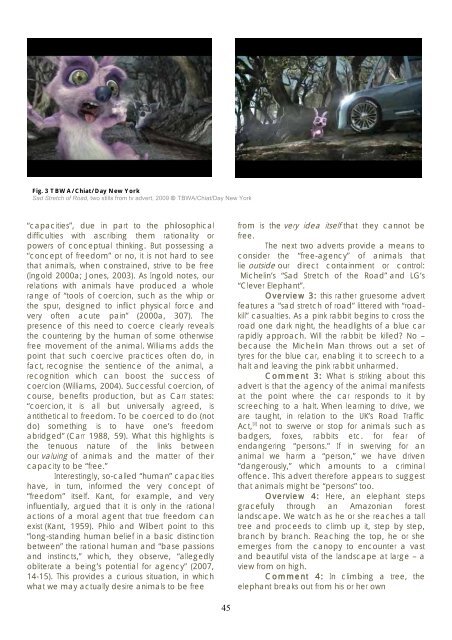Marketing Animals - Antennae The Journal of Nature in Visual Culture
Marketing Animals - Antennae The Journal of Nature in Visual Culture
Marketing Animals - Antennae The Journal of Nature in Visual Culture
Create successful ePaper yourself
Turn your PDF publications into a flip-book with our unique Google optimized e-Paper software.
Fig. 3 TBWA/Chiat/Day New York<br />
Sad Stretch <strong>of</strong> Road, two stills from tv advert, 2009 TBWA/Chiat/Day New York<br />
“capacities”, due <strong>in</strong> part to the philosophical<br />
difficulties with ascrib<strong>in</strong>g them rationality or<br />
powers <strong>of</strong> conceptual th<strong>in</strong>k<strong>in</strong>g. But possess<strong>in</strong>g a<br />
“concept <strong>of</strong> freedom” or no, it is not hard to see<br />
that animals, when constra<strong>in</strong>ed, strive to be free<br />
(Ingold 2000a; Jones, 2003). As Ingold notes, our<br />
relations with animals have produced a whole<br />
range <strong>of</strong> “tools <strong>of</strong> coercion, such as the whip or<br />
the spur, designed to <strong>in</strong>flict physical force and<br />
very <strong>of</strong>ten acute pa<strong>in</strong>” (2000a, 307). <strong>The</strong><br />
presence <strong>of</strong> this need to coerce clearly reveals<br />
the counter<strong>in</strong>g by the human <strong>of</strong> some otherwise<br />
free movement <strong>of</strong> the animal. Williams adds the<br />
po<strong>in</strong>t that such coercive practices <strong>of</strong>ten do, <strong>in</strong><br />
fact, recognise the sentience <strong>of</strong> the animal, a<br />
recognition which can boost the success <strong>of</strong><br />
coercion (Williams, 2004). Successful coercion, <strong>of</strong><br />
course, benefits production, but as Carr states:<br />
“coercion, it is all but universally agreed, is<br />
antithetical to freedom. To be coerced to do (not<br />
do) someth<strong>in</strong>g is to have one’s freedom<br />
abridged” (Carr 1988, 59). What this highlights is<br />
the tenuous nature <strong>of</strong> the l<strong>in</strong>ks between<br />
our valu<strong>in</strong>g <strong>of</strong> animals and the matter <strong>of</strong> their<br />
capacity to be “free.”<br />
Interest<strong>in</strong>gly, so-called “human” capacities<br />
have, <strong>in</strong> turn, <strong>in</strong>formed the very concept <strong>of</strong><br />
“freedom” itself. Kant, for example, and very<br />
<strong>in</strong>fluentially, argued that it is only <strong>in</strong> the rational<br />
actions <strong>of</strong> a moral agent that true freedom can<br />
exist (Kant, 1959). Philo and Wilbert po<strong>in</strong>t to this<br />
“long-stand<strong>in</strong>g human belief <strong>in</strong> a basic dist<strong>in</strong>ction<br />
between” the rational human and “base passions<br />
and <strong>in</strong>st<strong>in</strong>cts,” which, they observe, “allegedly<br />
obliterate a be<strong>in</strong>g’s potential for agency” (2007,<br />
14-15). This provides a curious situation, <strong>in</strong> which<br />
what we may actually desire animals to be free<br />
45<br />
from is the very idea itself that they cannot be<br />
free.<br />
<strong>The</strong> next two adverts provide a means to<br />
consider the “free-agency” <strong>of</strong> animals that<br />
lie outside our direct conta<strong>in</strong>ment or control:<br />
Michel<strong>in</strong>’s “Sad Stretch <strong>of</strong> the Road” and LG’s<br />
“Clever Elephant”.<br />
Overview 3: this rather gruesome advert<br />
features a “sad stretch <strong>of</strong> road” littered with “roadkill”<br />
casualties. As a p<strong>in</strong>k rabbit beg<strong>in</strong>s to cross the<br />
road one dark night, the headlights <strong>of</strong> a blue car<br />
rapidly approach. Will the rabbit be killed? No –<br />
because the Michel<strong>in</strong> Man throws out a set <strong>of</strong><br />
tyres for the blue car, enabl<strong>in</strong>g it to screech to a<br />
halt and leav<strong>in</strong>g the p<strong>in</strong>k rabbit unharmed.<br />
Comment 3: What is strik<strong>in</strong>g about this<br />
advert is that the agency <strong>of</strong> the animal manifests<br />
at the po<strong>in</strong>t where the car responds to it by<br />
screech<strong>in</strong>g to a halt. When learn<strong>in</strong>g to drive, we<br />
are taught, <strong>in</strong> relation to the UK’s Road Traffic<br />
Act, [ii] not to swerve or stop for animals such as<br />
badgers, foxes, rabbits etc. for fear <strong>of</strong><br />
endanger<strong>in</strong>g “persons.” If <strong>in</strong> swerv<strong>in</strong>g for an<br />
animal we harm a “person,” we have driven<br />
“dangerously,” which amounts to a crim<strong>in</strong>al<br />
<strong>of</strong>fence. This advert therefore appears to suggest<br />
that animals might be “persons” too.<br />
Overview 4: Here, an elephant steps<br />
gracefully through an Amazonian forest<br />
landscape. We watch as he or she reaches a tall<br />
tree and proceeds to climb up it, step by step,<br />
branch by branch. Reach<strong>in</strong>g the top, he or she<br />
emerges from the canopy to encounter a vast<br />
and beautiful vista <strong>of</strong> the landscape at large – a<br />
view from on high.<br />
Comment 4: In climb<strong>in</strong>g a tree, the<br />
elephant breaks out from his or her own












